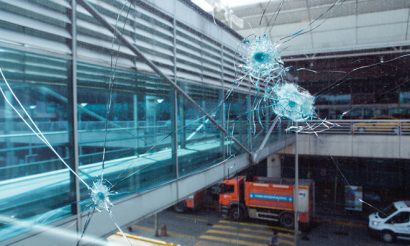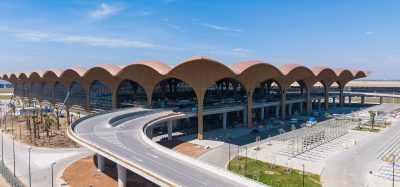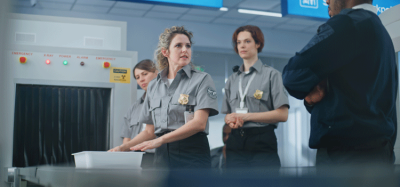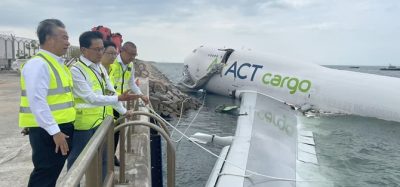The Security Series: Staying one step ahead of civil aviation threats
Posted: 29 November 2016 | Andy Blackwell | No comments yet
Andy Blackwell, former Head of Security with Virgin Atlantic examines the challenges industry and governments face when trying to stay one step ahead of unlawful interference to civil aviation….


Welcome to ‘The Security Series’ from International Airport Review, featuring an extensive insight into matters of aviation and airport security with interviews and opinion pieces from key industry leaders and experts.
Andy Blackwell, former Head of Security with Virgin Atlantic and now a Registered Independent Security Consultant specialising in Transport Security, examines the challenges industry and governments face when trying to stay one step ahead of those intent on causing acts of unlawful interference to civil aviation. This article focuses on how we can utilise our people, technology and legislation in the most effective combination to provide maximum security resilience.
Recent events once again serve to highlight the fact that terrorists retain an unhealthy interest in civil aviation. Analysis of previous incidents shows that the perpetrators are innovative in their approach, deploying techniques they may have previously used, but also seeking to devise and deploy new methods to target aviation assets.
Join us live: Shaping the Next Generation of Hold Baggage and Air Cargo Screening
Join us live for an insightful webinar on 11th December at 14:00 GMT, in collaboration with Smiths Detection, as we explore the strategic balance of operational efficiency, regulatory compliance, and sustainability in high-volume security environments.
This session offers a focused look into future-proofing your security strategy.
Key learning points
- Cost Reduction: Strategies to minimize bag travel time while simultaneously reducing operational costs.
- Regulatory Roadmap: Insights into the next wave of regulatory changes and their impact on future investment decisions.
- Sustainable Systems: Practical approaches to building sustainability into security systems and lowering the total cost of ownership (TCO).
- Scalable Solutions: Real-world examples of scalable systems supporting current airport growth and preparing for tomorrow.
Register now for expert insights, case studies, and actionable strategies on operational efficiency!
The dynamic threat environment that civil aviation operates within creates security challenges to our industry and there is always a need to review the latest attacks and attack plots to ensure that industry is best able to mitigate and respond. The aim is to break the ‘they act, we react’ cycle and try to get ahead of the curve, which in reality is a challenge in itself. It’s all too easy to say that terrorists will always have the upper hand as they are not constrained by finances, resources, legislation or ethics, but in my view we should always strive for security supremacy.


Intelligence has a key role to play in terms of identifying and thwarting terrorist plots against the industry and this is an area where clearly external agencies rightfully take the lead. Enhancing our knowledge of how and why terrorists plot against their targets makes a significant difference to the development of industry’s security strategies. Whilst there are obvious sensitivities around the need to protect intelligence sources and classified material, it is important that those at the sharp-end have the best possible information to be able to perform their security duties effectively.
“Whilst the robustness of aviation security is often criticised, it’s important to acknowledge the good work that’s being done by industry…”
The implementation and development of Security Management Systems (SeMS) will help provide assurance in relation to existing compliance and risk mitigation performance, whilst also identifying areas where further work is necessary. SeMS and other management systems encourage continuous improvement and positive change.
Whilst the robustness of aviation security is often criticised, it’s important to acknowledge the good work that’s being done by industry, regulators and government departments – notably the development and implementation of SeMS, overseas capability building and the advancement of projects looking at the future of security technologies, to name just a few. There are many unsung heroes within these groups and it’s important not to lose sight of all the positive steps being taken to further improve aviation security, whilst always recognising the need to keep security under constant review and strive for continuous improvement. Being nimble, creative and proactive in our approaches will help us get ahead of the curve.
Partnership approaches between key aviation stakeholders and relevant external agencies, particularly in terms of producing guidance material, work well and invariably enhance the effectiveness of the final product. There is no doubt that greater involvement of industry specialists to help support counter terrorism and aviation security strategies will be mutually beneficial and together we can make a positive difference.
Aviation remains the safest form of travel and, as has been quoted many times, the riskiest element of air travel is the drive to the airport. However, media images of airport and aviation attacks, as well as the reporting of terrorist plots targeting civil aviation, do understandably create public unease. This is one of the reasons why terrorists will always retain their focus on aviation assets. Within aviation security arrangements there are measures that add pure security value and others that are more focused on reassurance. Measuring and analysing security value and performance can be complex, particularly in the area of deterrence. Attempting to remove reassurance measures is likely to be challenging, as the public’s perception of aviation security and managing passengers’ confidence needs to be carefully managed.
There are no ‘silver bullets’ in the world of aviation security, but there are courses of action we can – and in many cases are already – taking to get one step ahead of those seeking to do us harm. We need to be as creative and innovative in our approaches as they are. With often limited resources, differentiation is key and we need to focus on areas where the risk is the greatest, whilst maintaining a solid baseline of measures at our airports.
Following SeMS best practices will deliver security beyond compliance and help us to get ahead of the curve. We can secure aviation by using a blended approach comprised of assurance, detection, disruption, deterrence and unpredictability. We need to ensure the security blend is as effective as it can be. The correct blend will maximise assurance and may need to be adapted in line with changes in the threat landscape.
When looking at how aviation security is managed, it is useful to identify the ‘inhibitors’; things that hinder us, and ‘enablers’; things that help us.
Inhibitors and enablers
Inhibitors
- Complacency
- Lack of clarity of requirements/complexity of regulation or processes
- ‘Knee jerk’ responses
- Poor security culture
- Lack of management commitment
- Predictability
- Afterthought security
- Insufficient funding
Enablers
- Security Management Systems (SeMS)
- Effective threat assessment and risk management
- Risk-based approach – focus on what is probable rather than what is possible
- Positive security culture
- Positive management commitment
- Unpredictability
- Security fully integrated into business activities
- Adequate funding
- Collaboration and partnership approaches
- Security performance measures
Focusing on the enablers will help improve an organisation’s security robustness. In addition, there are many weapons in our armoury that can enhance security. Deterrence messaging is utilised to good effect in a number of areas and is a useful additional measure to support conventional security measures. This needs to be centrally managed and woven into the fabric of our security operations, rather than be a one-off tactic. This particular measure has the potential to enhance deterrence and may help to flush out suspicious/unusual passenger behaviour. It’s important to refresh the deterrence regularly.
Behavioural detection is a key weapon in our security armoury; it’s not just about finding the bomb, but doing whatever we can reasonably do to find the terrorists with the bomb and the support networks behind them. Clearly this requires a multi-agency approach, which globally encompasses some excellent best practices.
“Behavioural detection is a key weapon in our security armoury…”
A greater focus on our people will help with motivation and drive a positive security culture. Mentoring can often be more effective than conventional training techniques, helping to create positive habit-forming to support robust security.
The aviation industry, like many others, is all too aware of the threat posed by insiders, particularly in view of the publicised cases involving industry personnel with links to terrorist groups with a proven record of attacking and plotting to attack aviation assets. This is an area where industry/government partnership working has been strong and remains so. Concepts linked to smarter referencing analysis and ongoing vetting practices (aftercare) are all useful tools that will further ‘target harden’ the industry, making it a hostile environment for terrorists and other criminals to operate in, or try to attack.
A number of well-publicised plots against civil aviation have demonstrated a high degree of sophistication and innovation on the part of the perpetrators, and our innovation in terms of detection capability needs to be greater than theirs. Good progress has been made in this area, with a number of joint industry/government projects and work streams in progress.
“In terms of security we need to be mindful that complexity can be as dangerous as complacency…”
Exploiting technologies for positive security benefit is key if we are to stay ahead of the game. Augmented reality has a number of potential security benefits, particularly in relation to threat management and risk assessment, as does social media analytics. An agile response to threats largely depends on information management and being able to rapidly access details of the security measures currently in place at particular locations. This includes security performance/compliance data, incident reports and other information sets crucial to those tasked with assessing and managing security threats and risks. The aviation industry has many forms and manual processes, many of which would benefit from automation.
Whilst it is acknowledged that we will not be able to stop each and every attack against the industry, there is much that can be done – and in many cases is being done – to ensure our response to the threat is the best it can be. Accounting for passengers and staff is vital and there are a number of technological solutions available to help locate people. Communication is key, particularly in light of the multiple number of security stakeholders operating in the airport environment. Some airports have already taken to learning from the retail industry and operate common radio channels for their security stakeholders. There is potential for this to be expanded at some airports. The ability to share situation reports and update multiple stakeholders with information that provides a wider context of security events is also important in today’s threat landscape.
Communication is key, particularly in light of the multiple number of security stakeholders operating in the airport environment…
Einstein’s famous quote “everything should be made as simple as possible, but not simpler” has always resonated with me. In the world of aviation there is great complexity – much of it justified – but in terms of security we need to be mindful that complexity can be as dangerous as complacency. If we make regulation and security procedures so complex that they are open to misinterpretation, or simply not followed, then all we have created is a false sense of security with additional risk. The fact that we have a procedure or regulation doesn’t mean it’s being implemented or correctly applied. The more we can keep security requirements simple to understand and comply with, the greater the chance we have of them being actioned as intended.
Conclusion
To conclude, there is much good work underway by industry, government and regulators to help maintain and enhance the integrity of aviation and critical national infrastructure security. The focus on SeMS – the building blocks of robust security and assurance – creates a solid foundation to build on. Increased partnership working, combining industry and government security expertise, will help ensure that we retain the correct security ‘blend’ and remain agile in our response to the inevitable security threats we will face in the future.
Biography
Andy Blackwell is former Head of Security with Virgin Atlantic and now Director of Blackwell Security Consulting, specialising in SeMS development. He has been commended by the Metropolitan Police for demonstrating a high degree of professionalism and providing an exceptional level of service during a period of heightened threat against civil aviation.
The Security Series
Exclusive interview with Angela Gittens, Director General of ACI World
Exclusive interview with Henrik Hololei, European Commission
Andy Blackwell: Staying one step ahead of civil aviation threats
James Braver; Peter DiDomenica: Securing the public side of airports
Solomon Wong; Karen Warnick-Elinan, InterVISTAS: Key trends in border preclearance
Exclusive interview with Ken Thomas Head of the Network Operations Coordination Unit at EUROCONTROL
David Henson: An airline’s perspective
Look out for the next feature in International Airport Review’s ‘Security Series’ coming very soon…
If you agree with International Airport Review in that matters of airport and aviation security are of the utmost importance, we suggest you register your interest in Airport IT & Security 2017, Vienna as we aim together to drive forward progress on this extremely pressing issue.
Stay Connected with International Airport Review — Subscribe for Free!
Get exclusive access to the latest airport and aviation industry insights from International Airport Review — tailored to your interests.
✅ Expert-Led Webinars – Gain insights from global aviation leaders
✅ Weekly News & Reports – Airport innovation, thought leadership, and industry trends
✅ Exclusive Industry Insights – Discover cutting-edge technologies shaping the future of air travel
✅ International Airport Summit – Join our flagship event to network with industry leaders and explore the latest advancements
Choose the updates that matter most to you.
Sign up now to stay informed, inspired, and connected — all for free!
Thank you for being part of our aviation community. Let’s keep shaping the future of airports together!



















